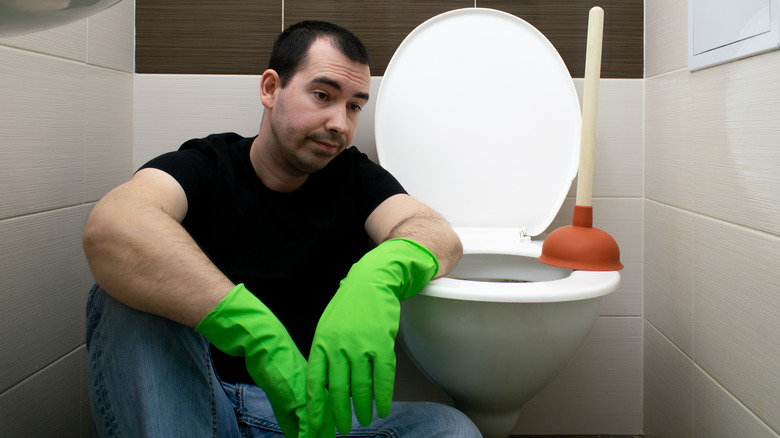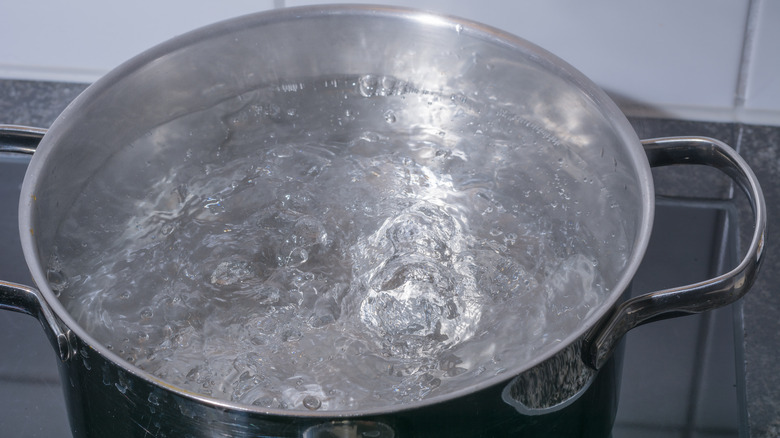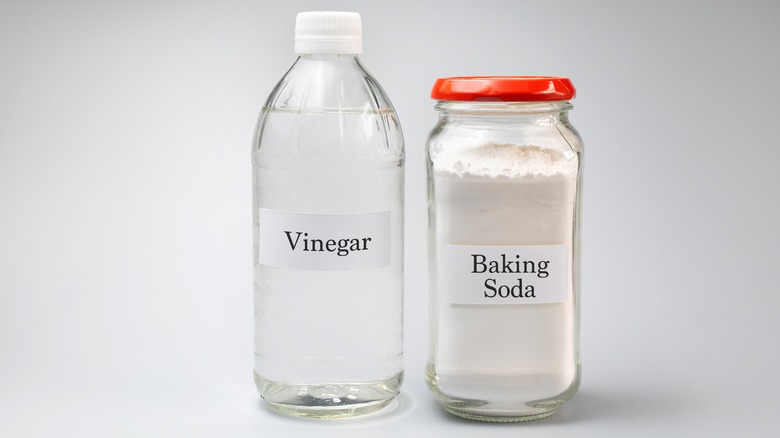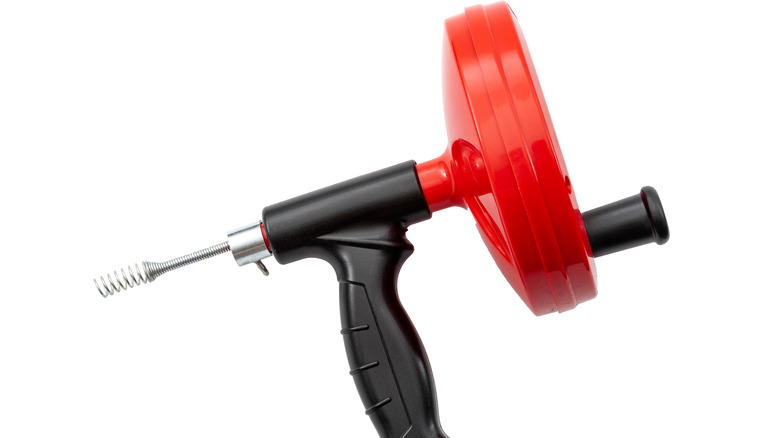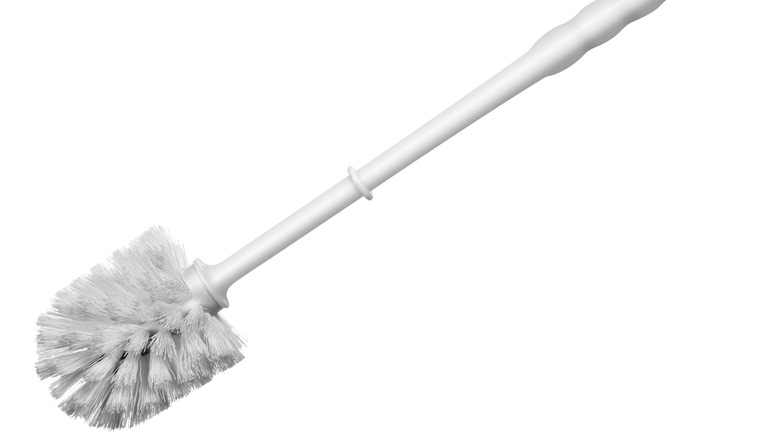5 Ways To Unclog Your Toilet If You Don't Have A Plunger
Clogged toilet? You're not alone. According to a Kohler survey (via Supply House Times,) an estimated 28 million American residents experience a clogged toilet every month. Even homeowners who take precautions and avoid flushing items that clog toilets – such as baby wipes, cat litter, tissues, paper towels, and dental floss — are not exempt. In addition, a toilet drain can also get jammed up due to unexpected factors, such as hard water build-up, a slow septic system, inadequate supply from the water tank, and aged pipework, explains All City Plumbing.
Since a clogged toilet can become a complete interruption to your livelihood, it's important to resolve it immediately. While the most popular toilet unclogging tool is a plunger, unfortunately, not every homeowner has one readily available. For this reason, we have created a roundup of the most effective ways you can unclog your toilet if you don't have a plunger.
Hot water and dish soap
Every toilet has a U-shaped or S-shaped trap that connects the waste pipe to the toilet bowl. According to H2-Pro Plumbing, the main purpose of the trap is to prevent the escape of foul-smelling gases from the sewer into the bathroom. However, solid waste or objects dropped down the toilet can often get trapped in this pipe and build up into a hard blockage.
One of the best remedies is dish soap and hot water. As explained by Toilet Haven, the dish soap lubricates the inner wall of the pipe while the hot water dissolves the clogs. First, you need to empty the toilet bowl to enable the dish soap to reach and penetrate the blockage. To do this, cut the toilet water supply and scoop the contents of the toilet bowl into an empty bucket. With the bowl empty, add 1/2 cup of dish soap and allow it to sit inside the toilet for 20 minutes, then flush it with 2 gallons of boiled water. Finally, restore the water supply and flush the toilet once the tank is filled up. Your toilet should flush freely now.
A fizzy fix with vinegar and baking soda
Winters Home Services claim that a combination of baking soda and vinegar poured directly into a toilet bowl can unlock its jammed drain. These two home ingredients react to create hissing gas bubbles strong enough to remove clogs. Before attempting this method, remember to wear protective goggles and keep a distance from the toilet bowl during the reaction so you don't get hit by any nasty splashes.
To start the process, Mr. Rooter Plumbing states to close the shut-off valve on the wall behind the toilet tank and remove some of the water inside the toilet bowl. The reason for this is to keep the toilet bowl's water level at half in order to minimize the chances of spillage – if the water level is too low, add to it from the closest faucet, preferably hot water. Once done, add 1 cup of baking soda to the toilet bowl, then another cup of vinegar, and close the toilet lid. After 20 minutes, try flushing it — if it's still clogged, repeat the process a few more times, using a greater amount of baking soda and vinegar.
Drain snake
According to ABC Southwest Plumbing & Air Conditioning, a drain snake is a hand- or motor-driven auger used for clearing the drains of washing machines, kitchens, sinks, and bathtubs. It is also used for unclogging sewer main lines and main drains. To snake a clogged toilet, Bungalow explains that you should place the cable end of the drain snake into the toilet bowl and force it through the clogs by turning the handle clockwise. Moving the handle anti-clockwise retracts the cable end, and you need to keep inserting and retracting the cable until the clog is either pushed down the drain or lifted out during the cable retraction.
A wire coat hanger can also be converted into a homemade drain snake. As instructed by Toiletseek, unwind the hanger until it becomes a long strip with a hook on one end. Cut a rag into small pieces and wrap them around the hook part — use duct tape to hold the setup in position. With your homemade drain snake ready, lower the hook end into the toilet bowl and force it through to dislodge the clogs in the drain. Complete the process by flushing water into the toilet bowl to test the results.
Make a homemade plunger
Yes, you read that right. You can build a plunger out of a plastic water bottle in two easy ways and use it to clear a seriously blocked toilet bowl. Before the plunging process, remember to prepare your toilet bowl for easy clearing by relieving it of its content. As shared by The Bottle House Brewing Company, the first method to creating a plunger is to cut away the bottom part of a plastic water bottle — depending on the size of your drain, you may need to use a 2-liter water bottle. Make sure the bottle cap is securely tightened, and –– with your gloves on –– thrust the end you've cut open up and down in the toilet bowl to create enough pressure to loosen the clogs.
The second method is similar but much easier. Fill a 2-liter plastic bottle with warm water and gently lower it into the empty toilet bowl. Open the bottle cap and squeeze-shoot the warm water forcefully into the drain to dissolve and knock out clogs.
Try Epsom salt, bleach, or toilet brush
If you're low on options, you can try any of these three less common toilet unclogging hacks. The first one is to leave Epsom salt inside the toilet bowl for a few minutes — or rock salt for eight hours — and flush it with hot (not boiled) water afterward. But, if you don't have Epsom salt, you can use a mix of table salt and baking soda. As explained by Bomisch, pour 12 cups of hot water into your toilet bowl and allow 1 cup of table salt and 1 cup of baking soda to sit overnight. The next morning, flush the toilet with a bucket of hot water.
While unclogging your drains with bleach is not as effective as other methods, it can be a lifesaver in the case of an emergency. According to Dial Up Plumbing, leave 1 to 4 cups of bleach in an empty toilet bowl for 15 minutes and flush the toilet after. Alternatively, if the waste causing the blockage is not too far into the drain, you can attempt to push it out with a toilet scrubbing brush, HVAC Seer writes. Simply place a plastic bag over the bristles of the toilet brush and use it to plunge the toilet bowl repeatedly.
